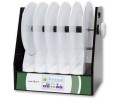Authors
V. Bouët, T. Freret, J. Toutain, D. Divoux, M. Boulouard et al.
Lab
University of Caen Basse-Normandie, CYCERON, UMR 6185 - CNRS, Neurodegenerescence: models and therapeutic strategies, Caen, France.
Journal
Experimental Neurology
Abstract
Whereas behavioral impairments after stroke are increasingly studied in the rat, little is known about the long-term functional consequences of focal ischemia in the mouse. To address this issue, Swiss mice underwent transient (60 min) intraluminal occlusion of the middle cerebral artery (MCAo) or sham surgery. Sensorimotor (chimney, accelerating rotarod, pole, corner, adhesive removal and staircase tests) and cognitive (passive avoidance and Morris water maze) performances were regularly assessed during 1 month, after which the final histological lesion was measured. Motor coordination and balance, assessed by the chimney and rotarod tests, were transiently altered by MCAo. Moreover, bradykinesia was evidenced by the pole test. The most striking and long-lasting (1 month) sensorimotor deficits were postural asymmetries on the corner test, bilateral skilled forepaw reaching deficits on the staircase test and a contralateral sensorimotor impairment on the adhesive removal test. MCAo animals showed normal spatial learning abilities on the Morris water maze test, but they displayed learning deficits measured by the passive avoidance test. This latter deficit was significantly correlated with both cortical and striatal damage. Our findings demonstrate the usefulness of three tests that had never been reported in the mouse after ischemia: the adhesive removal, staircase and pole tests, which showed deficits 1 month after ischemia and should therefore constitute meaningful tools in mice for assessing both neuroprotective and regenerative therapies in stroke preclinical studies.
BIOSEB Instruments Used:
Aron Test or Four Plates Test (LE830),Rotarod (BX-ROD)

 Pain - Thermal Allodynia / Hyperalgesia
Pain - Thermal Allodynia / Hyperalgesia Pain - Spontaneous Pain - Postural Deficit
Pain - Spontaneous Pain - Postural Deficit Pain - Mechanical Allodynia / Hyperalgesia
Pain - Mechanical Allodynia / Hyperalgesia Learning/Memory - Attention - Addiction
Learning/Memory - Attention - Addiction Physiology & Respiratory Research
Physiology & Respiratory Research
 Pain
Pain Central Nervous System (CNS)
Central Nervous System (CNS) Neurodegeneration
Neurodegeneration Sensory system
Sensory system Motor control
Motor control Mood Disorders
Mood Disorders Other disorders
Other disorders Muscular system
Muscular system Joints
Joints Metabolism
Metabolism Cross-disciplinary subjects
Cross-disciplinary subjects SFN2024: Meet our team in Chicago on booth #876
SFN2024: Meet our team in Chicago on booth #876 